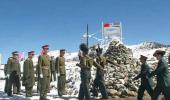'If the nub of India's sensitivity over the Chinese presence in Doklam is the enhanced threat to the Siliguri Corridor, a vital link to the northeast, does it serve the national purpose to have the districts along it, and then much of the tribal northeast, in turmoil?' asks Shekhar Gupta.

Photograph: PTI Photo
The past few weeks have exposed us to an unknown strategic reality: The Chinese media.
Through this ongoing tussle in Doklam, it has continued to raise the alert levels to deeper shades of pink, now near-red.
An editorial in the State-run Global Times was intemperate, calling External Affairs Minister Sushma Swaraj 'a liar' and threatening war at many points across the frontier.
It says however well-prepared India may be, in the end China will win because it spends four times as much on defence (an understatement) and has five times the economy.
Nobody in India is quaking at these fulminations. My first instinct would have been to laugh.
My first reaction was also to ask why the Government of India was still keeping its own 'North Korean channels' (Arun Shourie's priceless description) in the barracks?
Just like the Chinese, our media is ready for the fight too, so unleash them. That would teach them a lesson.
The reason I wouldn't do so is simple. Our warrior media is privately-owned.
It merely takes the cue from the establishment and launches fake, politically loaded wars on enemies, internal (mostly imaginary) or external.
It does so because empty jingoism equals ratings and it's good to have a powerful government on your side.
This Indian media does not speak for the government, which has plenty of room to manoeuvre on policy.
The Chinese media, on the other hand, is State-owned. Beijing speaks through it. That's why you have to take notice of it.
You must never let it intimidate you, but you can't toss it with a laugh and switch channels.
For decades, China-watchers in Beijing, their old hangout Hong Kong and now across world capitals have micro-analysed commentaries in Chinese State media.
If you dissect the Global Times editorial line-by-line and separate the blustery chaff from substantive grain, a few things stand out.
One, that Doklam is a symbol, but the Chinese fulmination is over a larger, strategic issue.
They resent India continuing to pretend to be an Asian power and the only major country in the world to openly oppose and boycott its Belt and Road Initiative when even the United States, Japan and Australia, members of the quadrilateral with India, participated in deliberations over it.
Second, they are rising openly for proxy Pakistan.
Third, they are conveying a more arrogant message: You declare yourselves a big power too soon. You aren't in our league yet.
Because, besides a much smaller economy and military, you also have many chronic weaknesses you've failed to address.
China's irritation with the strengthening Japan-US-India axis is understandable, coming as it does in the week of the trilateral exercise Malabar.
India is delusional to count on Japanese and US help in the case of conflict, it says, because this help is 'illusory'.
But, to my mind, the most important line of the statement comes next: 'If India fancies the idea that it has a strategic card to play in the Indian Ocean, it could not be even more naïve.'
'China does hold a lot of cards and can hit India's Achilles' heel, but India has no leverage at all to have a strategic showdown with China.'
Given how seriously the Chinese State media is taken for its diplomatic and strategic messaging, it is adept at weighing its words carefully.
But arrogance makes you slip up and give away what's on your mind. The reference to India's Achilles' heel is an example of this.
It is strategic messaging in anger and an alert India should wake up.
Does this mean China is threatening to get the Pakistanis to light up the Line of Control and the Kashmir valley? Some of that has already started.
Does it mean creating fresh anxieties across India's other borders, especially Nepal? The Chinese can do so at will, given how messed up India's Nepal policy currently is.
Does it mean more Chinese submarines bobbing in Chittagong, Sri Lankan and Pakistani ports?
Does it mean getting insurgencies in east-central India (Maoists) and the northeast, especially Nagaland and eastern Arunachal/Assam, activated again?
Could it be all of the above? Or more? Which should call for some introspection.
Right next to Sikkim, where the current trouble is located, Darjeeling has been burning for weeks now.
West Bengal, the state which governs Darjeeling, is in communal turmoil. It is more exaggerated than real, but situations like these can easily go out of control -- in fact they usually do.
The army, notably, had to be called out in recent weeks in Darjeeling.
In the middle of this, the Nagaland government has fallen and a new (more Bharatiya Janata Party-friendly) one has just been installed with the help of a friendly governor and defectors, upsetting a delicate inter-tribal balance of power and destabilising the ongoing -- but stalling -- peace negotiations as hostile groups gather strength.
Another front has opened up in the same region, with a group of Tripura tribals demanding a separate state and blocking the national highway.
If the nub of India's sensitivity over the Chinese presence in Doklam is the enhanced threat to the Siliguri Corridor, a vital link to the northeast, does it serve the national purpose to have the districts along it, and then much of the tribal northeast, in turmoil?
The Chinese have some leverage with the east-central Maoists, but they are much weakened already.
Pakistani allies can continue escalating Kashmir. But these may not be what they are calling our Achilles' heel.
It is closer to Doklam, in a wide semi-arc going deep north into Bengal districts abutting the Siliguri Corridor and eastwards into the fragile border states of the northeast.
How do you describe a situation where your Achilles' heel is actually your delicately placed jugular?
It's a strategic nightmare and that is what the Chinese have unwittingly reminded us of.
There are limits to what India can do to calm Kashmir and the LoC in the short run.
Sizable Indian forces, including several mountain divisions, will remain pinned down on the Pakistan frontiers.
Maoists can only be a nuisance, but too far and marginal to be a strategic liability.
West Bengal and the Northeast are different, particularly because the multiple ongoing crisis there are unnecessary and self-inflicted, a direct result of the BJP's relentless ambition to finally conquer the region.
It's a tap the BJP opened, and it can tighten it shut.
Politics will never go out of our lives, and a leader with the strength and authority of Prime Minister Narendra Modi can wait. He should firmly order a break in hostilities on these internal fronts.
Political instability in Nagaland now, the Darjeeling agitation and this utter shocker of a tribal uprising in Tripura -- by far the most peaceful state in the region, only one with Armed Forces (Special Powers) Act withdrawn from all districts -- all have his party's political fingerprints.
He must tether his interventionist governors, and Rashtriya Swayamsevak Sangh commandoes and special forces should be called back to the barracks, for now.
There is a much stronger enemy at the gates. It has even alerted you to vulnerabilities of your own creation.
Take advantage of that arrogant indiscretion and put your own house in order.
The party's conquest of the Northeast can be resumed later.











